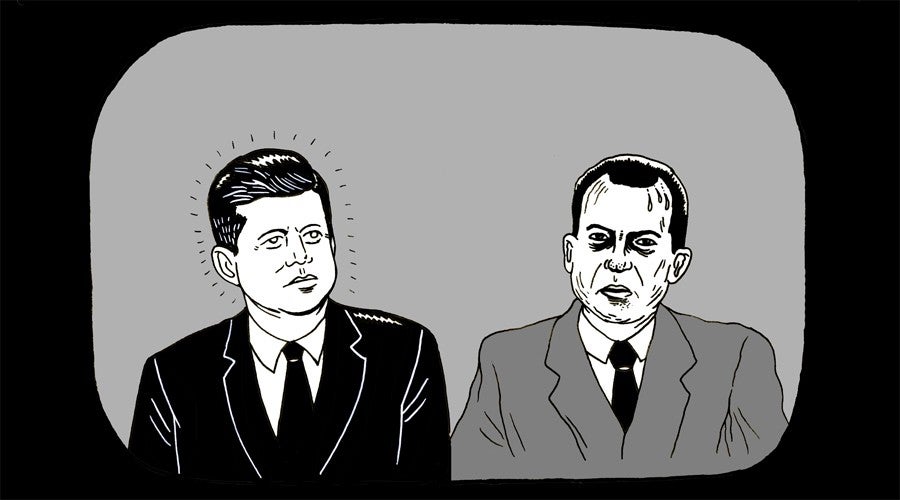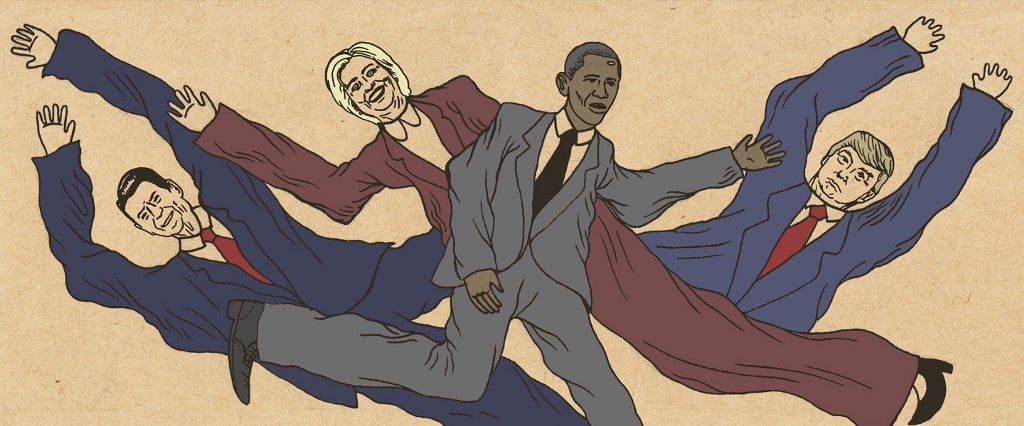You’ve probably spent much of this election season wondering why Trump does so many of the horrible things he does — including wearing terrible suits.
There’s no excuse for this. Anyone who can afford a billion-dollar tax writedown can afford a tailor. Not to mention the man once had his own line of menswear. You’d think he’d have several closets full of bespoke threads, and yet his jacket and pants are consistently baggy and rumpled, his lapels are oppressively wide and his ties are too long. All of it calls to mind the monstrous fashion of Reagan-era Wall Street.
And it’s not just Trump. The Republican primary debates were the sartorial opposite of a men’s fashion show — a row of men dressed in uniformly unimpressive, boxy navy suits (and red or blue ties).
The entire reason for wearing a suit is to seem fit for office. “A suit indicates a serious commitment — it is a formal statement that you take the job and world seriously,” says John Murphy, a communications professor at the University of Illinois. “That means a tailored suit.”
Why, then, do so many politicians end up looking like teenagers wearing their dad’s suit to their first job interview?
“I’ve had this conversation with many people before: ‘Why can’t they wear better suits?’” says Josh Nanberg, owner of Ampersand Strategies, a D.C.-based political consulting firm. “And we’ve never arrived at a satisfying answer.”
Nanberg has spent the past 15 years working on campaigns, from small-town council races to Bill Clinton’s 1996 re-election bid, and says he frequently has to convince clients to dress up, not down. “I’ve often had to have that awkward conversation with a candidate about looking like they belong on the job.”
But Nanberg says the ill-fitting suit is due, in part, to the rigors of the campaign trail. Candidates shuffle from luncheon to speaking event to town hall to donor dinner, and their suits get wrinkled. And the hectic schedule causes their weight to fluctuate, which means suits that started out well-fitting may not stay that way.
And experts agree politicians wear underwhelming suits to avoid looking elitist. After all, it’s hard to relate to the average John Q. Public in a bespoke three-piece ensemble from Tom Ford. The desire to seem like a regular working Joe is why politicians often ditch the tie and jacket and roll up their sleeves during town hall-style events.
Dressing for the presidency is a delicate art, then — one that requires candidates to strike the perfect balance between professional and folksy. “You have to show that people from all classes, especially working and middle classes, can identify with you,” says Barry Brummett, a professor of communication at the University of Texas. “You can’t go on wearing overalls, but you also can’t be too flashy.”
The notable exceptions are John F. Kennedy and President Obama.
Hillary Clinton Is Our Only Chance to Keep the Presidency Hot
JFK’s legacy includes being remembered as America’s most stylish president. He was the first president to wear a two-button suit jacket, and Brooks Brothers now has a suit style named after him. “JFK changed shirts a couple times a day,” Murphy says. “He wanted to feel and look good.”
In fact JFK won the election in 1960 in part because he looked so good in a suit. The September 26, 1960, presidential debate was the first in American history to air on television, and viewers became enamored of the well-coiffed Kennedy, especially in comparison with Republican opponent Richard Nixon. There was Nixon — sweaty and jowly, scaring the nation’s children. And then there was Kennedy — tall and handsome, with a lush head of hair, looking dapper in a form-fitting suit with long, thin lapels. Neither boxy nor restrictive, the suit was distinguished without being showy.

You’d think Kennedy would have ushered in an era of excellently dressed presidents, but he proved to be the exception. Ronald Reagan was deemed bold simply for wearing a brown suit in office. Bill Clinton’s suits were on the broad-shouldered side, as was the style in the ’90s. He’s upped his style since leaving office, but still he’s still remembered for his dopey jogging outfits. George W. Bush wore unremarkable navy and gray suits, and people tend to associate him with ranching gear instead.
Aside from his fondness for tan, Obama isn’t the most adventurous dresser. He wears only gray and blue to cut down on “decision fatigue” — the psychological toll of having to make many decisions, large or small. “I don’t want to make decisions about what I’m eating or wearing,” Obama told Vanity Fair. “Because I have too many other decisions to make.”
#Obama in a #TanSuit? What message is the President trying to send? @FoxNews' @EdRollins on Obama’s image issues pic.twitter.com/iGSnhHFgM3
— Lou Dobbs (@LouDobbs) August 28, 2014
But Obama’s suits always fit him well, which puts him far ahead of most other presidents. His shoulders don’t slope and his sleeves are cut to a shorter, more contemporary length. Obama’s also known for his casualwear, specifically his penchant for wearing a suit without a tie. Meanwhile, “Trump hasn’t had a suit that fit the entire campaign, which is remarkable, especially in the wake of Obama,” Murphy says.
Toeing the line between formal and relatable is even tougher for female candidates, says Jason Levin, of the L.A.-based PR shop Cerrell Associates. Pundits obsess over what Hillary Clinton wears. Critics blasted her this summer for having the audacity to wear a $12,000 Armani jacket, for instance, but she has been praised for the Ralph Lauren suits she wore to the three presidential debates. As is tradition, she stayed within the stars-and-stripes color palette: She wore red at the first, navy at the second and cream at the last (as she did the night she was nominated, in a nod to early Suffragettes, who wore white).
“You want the voter to be concentrated not on what you’re wearing, but what you’re trying to communicate,” Levin says. “You don’t see politicians wearing bold patterns for that exact reason.”
Trump’s rhetoric is already bold enough, so perhaps it makes sense his presentation is, to put it gently, unremarkable. Or perhaps he’s just proof that money can’t buy taste.
